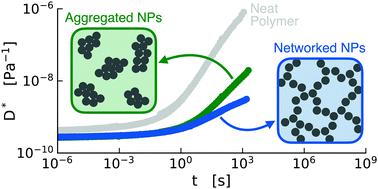当前位置:
X-MOL 学术
›
Soft Matter
›
论文详情
Our official English website, www.x-mol.net, welcomes your
feedback! (Note: you will need to create a separate account there.)
Creep attenuation in glassy polymer nanocomposites with variable polymer-nanoparticle interactions.
Soft Matter ( IF 2.9 ) Pub Date : 2020-09-08 , DOI: 10.1039/d0sm01247e C Francisco Buitrago 1 , James F Pressly 1 , Anita S Yang 2 , Peter A Gordon 3 , Robert A Riggleman 2 , Bharath Natarajan 3 , Karen I Winey 4
Soft Matter ( IF 2.9 ) Pub Date : 2020-09-08 , DOI: 10.1039/d0sm01247e C Francisco Buitrago 1 , James F Pressly 1 , Anita S Yang 2 , Peter A Gordon 3 , Robert A Riggleman 2 , Bharath Natarajan 3 , Karen I Winey 4
Affiliation

|
The use of nanoparticle reinforced polymer matrices in continuous fiber composites for infrastructure applications requires a comprehensive understanding of viscoelastic creep. Critical parameters affecting the mechanical reinforcement offered by nanoparticles include nanoparticle size and concentration, as well as the interaction between the nanoparticle surface and polymer matrix. Here, we study the viscoelastic creep of nanocomposite systems comprised of glassy thermoplastic polymers and spherical silica nanoparticles of varying sizes and surface functionalization using a dynamic mechanical analysis (DMA) accelerated testing methodology. Significant differences in the nanoparticle dispersions in these nanocomposites were observed via transmission electron microscopy (TEM) and small-angle X-ray scattering (SAXS) and are attributed to differences in the polymer–polymer and polymer–particle interaction strengths. The DMA measurements indicate a decrease in compliance at short times with increased nanoparticle loading that is largely independent of nanoparticle dispersion morphology and polymer–particle interaction strength. Conversely, long term creep behavior shows a much stronger dependence on these parameters with the creep onset time increasing by up to three orders of magnitude. For similar nanoparticle loadings, the time to critical deformation in systems with well-distributed, networked nanoparticle morphologies was larger by an order of magnitude compared to systems exhibiting strong nanoparticle aggregation. The networked systems delayed the time to critical deformation by three orders of magnitude over that of neat polymer. The increase in time to critical deformation is also greater in composites with smaller nanoparticles at similar loadings, which we attribute to the development of percolated nanoparticle networks. These results demonstrate the significant effects polymer–particle interactions and dispersion morphologies can have on the long-term creep compliance of thermoplastic nanocomposites.
中文翻译:

具有可变的聚合物-纳米粒子相互作用的玻璃状聚合物纳米复合材料的蠕变衰减。
在基础设施应用的连续纤维复合物中使用纳米颗粒增强的聚合物基体需要对粘弹性蠕变有全面的了解。影响纳米颗粒提供的机械增强作用的关键参数包括纳米颗粒的大小和浓度,以及纳米颗粒表面和聚合物基质之间的相互作用。在这里,我们使用动态力学分析(DMA)加速测试方法研究了由玻璃态热塑性聚合物和球形二氧化硅纳米粒子组成的纳米复合材料系统的粘弹性蠕变,这些纳米粒子具有不同的尺寸和表面功能化。通过观察,在这些纳米复合物中的纳米颗粒分散体存在显着差异。透射电子显微镜(TEM)和小角X射线散射(SAXS),归因于聚合物-聚合物和聚合物-颗粒相互作用强度的差异。DMA测量结果表明,随着纳米颗粒负载量的增加,短时间内的顺应性降低,这在很大程度上与纳米颗粒的分散形态和聚合物-颗粒之间的相互作用强度无关。相反,长期蠕变行为显示出对这些参数的依赖性更大,蠕变开始时间最多增加三个数量级。对于相似的纳米粒子负载,与表现出强纳米粒子聚集的系统相比,具有良好分布的,网络化纳米粒子形态的系统中达到临界变形的时间要大一个数量级。网络系统将临界变形的时间比纯聚合物延迟了三个数量级。在相似载荷下具有较小纳米颗粒的复合材料中,临界变形时间的增加也更大,这归因于渗透纳米颗粒网络的发展。这些结果表明,聚合物-颗粒之间的相互作用和分散形态对热塑性纳米复合材料的长期蠕变顺应性具有重大影响。
更新日期:2020-10-07
中文翻译:

具有可变的聚合物-纳米粒子相互作用的玻璃状聚合物纳米复合材料的蠕变衰减。
在基础设施应用的连续纤维复合物中使用纳米颗粒增强的聚合物基体需要对粘弹性蠕变有全面的了解。影响纳米颗粒提供的机械增强作用的关键参数包括纳米颗粒的大小和浓度,以及纳米颗粒表面和聚合物基质之间的相互作用。在这里,我们使用动态力学分析(DMA)加速测试方法研究了由玻璃态热塑性聚合物和球形二氧化硅纳米粒子组成的纳米复合材料系统的粘弹性蠕变,这些纳米粒子具有不同的尺寸和表面功能化。通过观察,在这些纳米复合物中的纳米颗粒分散体存在显着差异。透射电子显微镜(TEM)和小角X射线散射(SAXS),归因于聚合物-聚合物和聚合物-颗粒相互作用强度的差异。DMA测量结果表明,随着纳米颗粒负载量的增加,短时间内的顺应性降低,这在很大程度上与纳米颗粒的分散形态和聚合物-颗粒之间的相互作用强度无关。相反,长期蠕变行为显示出对这些参数的依赖性更大,蠕变开始时间最多增加三个数量级。对于相似的纳米粒子负载,与表现出强纳米粒子聚集的系统相比,具有良好分布的,网络化纳米粒子形态的系统中达到临界变形的时间要大一个数量级。网络系统将临界变形的时间比纯聚合物延迟了三个数量级。在相似载荷下具有较小纳米颗粒的复合材料中,临界变形时间的增加也更大,这归因于渗透纳米颗粒网络的发展。这些结果表明,聚合物-颗粒之间的相互作用和分散形态对热塑性纳米复合材料的长期蠕变顺应性具有重大影响。











































 京公网安备 11010802027423号
京公网安备 11010802027423号